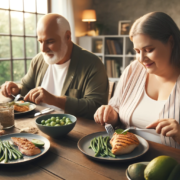Diabesity is a relatively new disease term that when you hear it for the first time, might sound vaguely familiar.
Diabesity Epidemic Explained
That’s because “diabesity” is a blend of two words — diabetes and obesity — conditions that have both reached epidemic proportions in the US and other countries.
The word “diabesity” was coined to describe the interrelationship and coexistence of both diabetes and obesity. It describes a pattern of blood sugar and insulin imbalances that if not corrected, typically lead to obesity and type 2 diabetes.
Diabestity Epidemiology Statistics
Medical doctors have long observed the link between obesity and type 2 diabetes in their patients, and numerous studies now confirm this link. A 2020 study from out of Denmark, for instance, showed that those who are obese have six times the risk of developing type 2 diabetes than “normal” weight individuals.!1
According to a research letter published in the Journal of the American Medical Association (JAMA), an estimated 93.3 million adults in the US are obese.2 And according to the Centers for Disease Control and Prevention (CDC), 34.2 million American adults have diabetes, and 88 million have prediabetes.3 (Prediabetes is a condition that if not reversed, typically becomes diabetes within a few years.)
Statics show a clear correlation between the twin epidemics of obesity and diabetes, too. For instance, between 1995 and 2008, rates of obesity in the US increased by approximately 10%, while incidents of diabetes increased by a whopping 90% over the same time period.!4
Obesity doesn’t always lead to type 2 diabetes, however, which mystifies researchers and is an area for further study.
Symptoms of Diabesity
The symptoms of this disease include blood glucose control/insulin resistance as well as those of metabolic syndrome.
Some of the most common symptoms include:
Abdominal fat
Cravings for starchy or sugary carbs
Frequent urination
Increased thirst
Difficulty losing weight
Elevated blood glucose levels
Abnormal cholesterol and/or triglyceride levels
High blood pressure
Systemic inflammation
Important note: obesity isn’t always a symptom of diabesity. In fact, thin people can experience these symptoms, and even develop full-blown type 2 diabetes.5
Diabesity Health Risk
Diabesity raises your blood glucose levels, which if left untreated, can damage every organ system in your body. Conditions associated with it include:
Heart disease
Stroke
High blood pressure
High cholesterol
Cancer
Sleep apnea and other respiratory disorders
Kidney disease/failure
Alzheimer’s and other forms of dementia
Limb amputation due to poor circulation
Eye diseases (retinopathy, glaucoma, cataracts)
Dietary Causes of Diabesity
This disease state is the result of poor blood glucose regulation that occurs from regularly eating simple sugars and processed and starchy carbs.
It works like this.
After you eat, your intestines break down the carbohydrates in food and convert it to glucose, a type of sugar. The glucose is then sent to your bloodstream, which causes your blood glucose levels to rise.
Almost everything you eat affects blood glucose levels. But simple sugars and refined starchy carbs cause huge spikes in blood glucose levels because they are digested quickly. (They contain little fiber to slow down digestion.)
By contrast, protein, fats, and non-starchy fibrous foods are slowly digested, which means that glucose slowly enters your bloodstream. This results in a gradual increase in blood glucose levels.
Your pancreas releases the hormone insulin to reduce the level of glucose in your blood. Insulin transports the insulin to your cells to be used for energy. The amount of insulin your pancreas produces depends upon the amount of glucose in your blood. The more glucose in your bloodstream, the more insulin your pancreas needs to produce.
When you have more glucose in your bloodstream than you can use at one time — as occurs with the consumption of processed carbs — insulin sends most of it to your fat cells. Eventually, this can lead to diabesity.
Also, excess glucose leads to excess insulin, eventually causing insulin resistance that elevates blood glucose levels. This further increases your risk of diabesity. Can you see how a diet of processed and starchy carbs causes weight gain and obesity?
As you can see, weight gain has little to do with the amount of food you eat. Weight gain is the result of eating predominantly poor-quality foods that spike your blood glucose levels and trigger an excessive insulin response.
Control your blood glucose and insulin levels, and you can control your weight. (That’s why the “glycemic index”, which assigns a number for the “glycemic load” of different foods, has become a popular and important reference these days.)
Dietary Solutions
So…if you want to prevent or reverse diabesity, eating a high-quality diet that keeps your blood glucose levels stable is a crucial first step.
Eat a High-Quality Diet
Eating a high-quality diet is the best thing you can do for your health in general and for diabesity in particular. To reverse your risk of diabesity, simply increase your intake of whole foods and decrease or eliminate your intake of heavily processed and starchy foods.
Limit your intake of sugary foods, too. The whole foods you’ll replace them with are nutritious and delicious, and include high-quality proteins, non-starchy veggies, and whole-food fats.
Eating a high-quality diet means you’ll have plenty of yummy choices while reducing or reversing symptoms of diabesity.
REFERENCES
1- Gordon S. Obesity Is Biggest Type 2 Diabetes Risk Factor. U.S. News & World Report. Apr 16,2020. https://www.usnews.com/news/health-news/articles/2020-04-16/obesity-is-biggest-type-2-diabetes-risk-factor
2- Hales CM, Fryar CD, Carroll MD, Freedman DS, Ogden CL. Trends in Obesity and Severe Obesity Prevalence in US Youth and Adults by Sex and Age, 2007-2008 to 2015-2016. JAMA. 2018;319(16):1723–1725. doi:10.1001/jama.2018.3060.
https://jamanetwork.com/journals/jama/fullarticle/2676543
3- Centers for Disease Control and Prevention. National Diabetes Statistics Report, 2020. Page last reviewed: Feb 11, 2020. https://www.cdc.gov/diabetes/library/features/diabetes-stat-report.html
4- Weatherspoon D. Statistics and facts about type 2 diabetes. MedicalNewsToday. Apr 1, 2019. https://www.medicalnewstoday.com/articles/318472
5- Kresser C. Diabesity: The #1 Cause of Death? Chris Kresser. May 2, 2019. https://chriskresser.com/diabesity-the-1-cause-of-death-and-disease/#:~:text=Diabesity%20is%20a%20constellation%20of%20signs%20that%20includes%3A,inflammation%206%20A%20tendency%20to%20form%20blood%20clots













